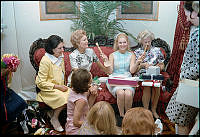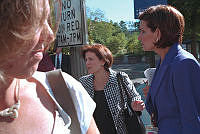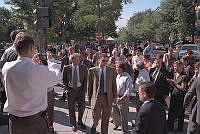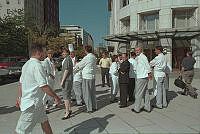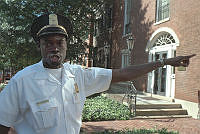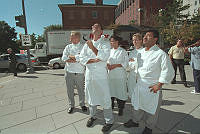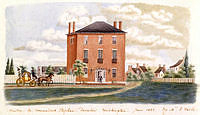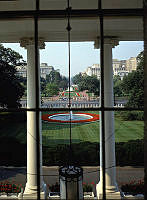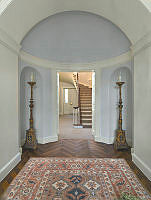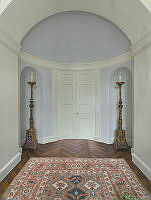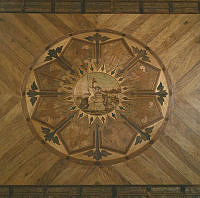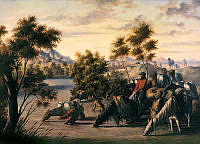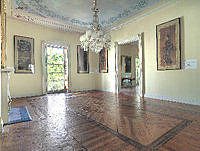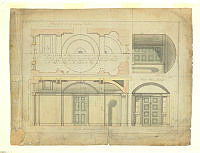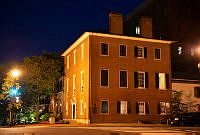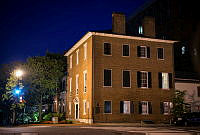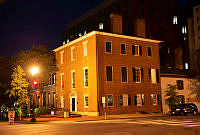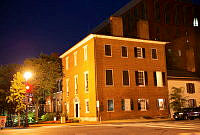History on the Auction Block
The 1899 Sale of the Estate of Dolley Madison
Copyright © Summer 2014 White House Historical Association. All rights reserved under international copyright conventions. No part of this article may be reproduced or utilized in any form or by any means, electronic or mechanical, including photocopying, recording, or by any information storage and retrieval system, without permission in writing from the publisher. Requests for reprint permissions should be addressed to books@whha.org
Dolley Madison died at her house on Lafayette Square on July 12, 1849. She was eighty-one. By that age she was one of the few women of note who remembered the founding fathers personally. There were others, most of them women like Mrs. Madison who had outlived their husbands. Elizabeth Schuyler Hamilton, widow of Alexander Hamilton was older and lived just up the street in Washington, and would live more years to come. But of the ladies who had been prominent in the early Republic, Mrs. Madison was the name that came first to mind.
She lay in state in her iron-galleried corner house and was buried from St. John’s Episcopal Church nearby, where she had been confirmed four years before. People recalled her vividly. She had lived among them for so long, wearing dresses and turbans long out of style, showing the young people her relics, the jewelry, the portraits, a desk actually built by James Madison, that most unlikely of handymen.

Dolley Madison’s portrait by Gilbert Stuart is now a part of the White House Collection. It is seen here in the Red Room in 2008. Her red velvet dress, sold at auction in 1899, is now at the Greensboro Historical Museum.
The White House Historical AssociationMrs. Madison had been married twice. The first time in her youth to a handsome young lawyer named John Todd, a fellow Quaker, and by whom she had two sons. John Todd died in the yellow fever epidemic of 1793, and their second son, an infant, died the same day. The surviving son Payne was to be both love and curse to her for the rest of her life.
Madison was introduced to her by Aaron Burr. The attraction was immediate, to put it mildly, and they soon married at her sister’s house in present West Virginia. Madison’s political career and great fame as a statesman placed her in the highest circles of power and wealth in the United States. If she lacked experience at first in such company, she readily captivated the strangers with her wit, charm, and kindness.

Illustration of Dolley Madison's dress up for auction.
The White House Historical AssociationAs first lady well before the term was conceived, Dolley Madison set the tone. There and at their Virginia farm, Montpelier, she and Madison extended warm hospitality. Burned out of the White House in 1814, they moved their “court” to rented quarters and resumed the pace. After the presidency, in 1817, the Madisons moved to Montpelier, where they were visited by successions of celebrities, scholars, artists, and old friends. In the saloon at Montpelier they displayed portraits of their friends who, like they, had helped build the American Republic. James Madison died in 1836, leaving her comfortably fixed, a happy situation her son Payne soon destroyed when he brought home his gambling debts, grandiose building schemes, not to mention costs from away from home activities that would have shocked his mother. For the rest of her life he would hang over her like a hungry buzzard, keeping her poor and worried. Only a return to public life seemed to counterbalance the situation. And at last this did come.

Dolley Madison lived in this house at the corner of Lafayette Park, just a block from the President’s House from 1844 until her death in 1849.
Library of CongressShe lost Montpelier. Returned to Washington in 1844, she was a vision from the past. Mrs. Dixon’s diary in our last issue gives several glimpses of her in her red ball dress, moving about again in political society. She was close to President and Mrs. Polk and livened their receptions and dinners. When in 1848 the validity was questioned of her rescue of the Washington portrait the night of the fire, she rose in anger and asked prominent friends to write and assure the press that her story was true.
After her death the possessions she had cherished went to her niece and great niece. At last in 1899, half a century after Mrs. Madison’s passing, they were put up for auction. The unknown person who attended and held the catalog we reproduce made notes in the margins of what the different items brought; the silver diadem, $15; the diamond ring Madison gave her upon their marriage, about $300. These circumstances of the sale are not why we print the catalog here. Our purpose is to give the reader the opportunity to peruse and imagine these fragments as bits of a larger, distant scene.
Gallery
-
 Courtesy of William Seale
Courtesy of William Seale -
 Courtesy of William Seale
Courtesy of William Seale -
 Courtesy of William Seale
Courtesy of William Seale -
 Courtesy of William Seale
Courtesy of William Seale -
 Courtesy of William Seale
Courtesy of William Seale -
 Courtesy of William Seale
Courtesy of William Seale -
 Courtesy of William Seale
Courtesy of William Seale -
 Courtesy of William Seale
Courtesy of William Seale -
 Courtesy of William Seale
Courtesy of William Seale -
 Courtesy of William Seale
Courtesy of William Seale -
 Courtesy of William Seale
Courtesy of William Seale -
 Courtesy of William Seale
Courtesy of William Seale -
 Courtesy of William Seale
Courtesy of William Seale -
 Courtesy of William Seale
Courtesy of William Seale -
 Courtesy of William Seale
Courtesy of William Seale -
 Courtesy of William Seale
Courtesy of William Seale -
 Courtesy of William Seale
Courtesy of William Seale -
 Courtesy of William Seale
Courtesy of William Seale -
 Courtesy of William Seale
Courtesy of William Seale -
 Courtesy of William Seale
Courtesy of William Seale -
 Courtesy of William Seale
Courtesy of William Seale -
 Courtesy of William Seale
Courtesy of William Seale -
 Courtesy of William Seale
Courtesy of William Seale -
 Courtesy of William Seale
Courtesy of William Seale -
 Courtesy of William Seale
Courtesy of William Seale -
 Courtesy of William Seale
Courtesy of William Seale -
 Courtesy of William Seale
Courtesy of William Seale -
 Courtesy of William Seale
Courtesy of William Seale -
 Courtesy of William Seale
Courtesy of William Seale -
 Courtesy of William Seale
Courtesy of William Seale













